As we drove home from exercise group last Saturday morning, it became clear that a big part of a tree had been cut down beside a warehouse-style business near home. A big chunk of tree canopy was lying on the footpath. I didn’t think I had sampled the tree in question, but there are several in that area that look like E Scoparia, but have been pruned to branch very high–out of reach. There isn’t much hope of my identifying this one–it has no fruit, flowers or buds on it right now, though it does have red twigs and white-barked branches and leaves the right shape for E Scoparia. I have had some success with leaves from the gutters on that street, but not right where these branches were lying. I went back and applied my secateurs.
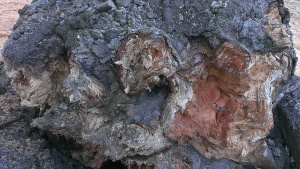
To my sadness when I actually stopped I could see that a tree had been felled and that its trunk had been taken away. The very base of it was all that was left, and it was clear that a large section of the root mass had rotted away or become diseased. Just the same… the continuing loss of trees around our way feels relentless. This week someone else aggrieved by the felling of three massive trees on one block which I posted about recently took a spray can to the fence of the block in question. One fence had something I can’t fully reprint here: ‘What the f*** have you done?’, and the other fence said the neighbourhood was in mourning for the loss of the trees and that planning laws should be changed. I thought I would take a photo but this morning there was a chap with a paintbrush taking it out less than 48 hours after it went up.
But this is no reason to allow all the leaves of this felled tree to go to commercial composting if I could dye with them and then compost them. Needless to say, after this flame orange result, I went back and cut all I could get into a chaff bag (that’s a very big sack, in my terms). As a bonus to my visit, the tree had been felled beside an E Cinerea, so I picked up every last leaf that had fallen from the E Cinerea too. I’ll be running a workshop at my Guild in June and I’ll need to bring a goodly amount of dye material.
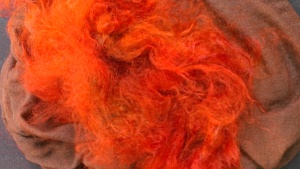
This next eucalypt was standing in the parklands in North Adelaide. I went there early one morning for an appointment so had a walk before my appointment. I decided to sample it because India Flint suggests silver grey leaved eucalypts are promising dye plants. The buds were so pretty!
Clearly when it flowers there are many flowers… but not yet…
The tree was an interesting shape…
There was the intriguing feature of two different coloured trunks coming from one lignotuber.
And I just can’t explain why there were so many land snails, but I love land snails.
The result in the dyebath was a pale apricot.
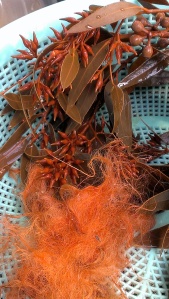
Then there was this tree, growing on the far outskirts of my workplace just outside a car park. It seems like a box (one branch of the eucalypt family) to me.
It was gloriously in flower, full of bees and birds.
When I went back in the evening, I realised there were a few of these trees and there were also fallen branches. Well worth sampling, in my view!
I loved the colour from this plant, and I used a dyeing strategy India Flint described in Melbourne. Far less energy use and potential for fibre damage… and clearly this may become my new normal way to dye with eucalypts!
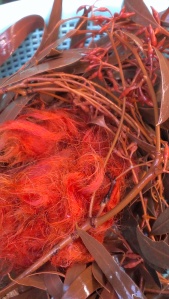

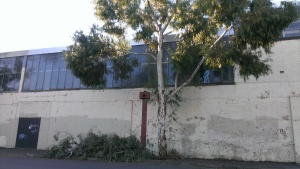
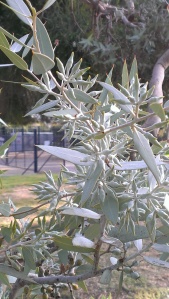
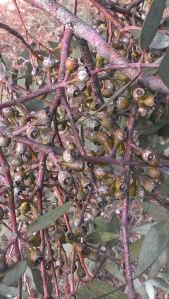
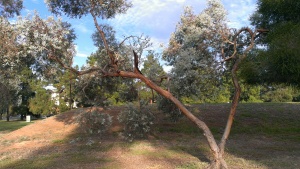
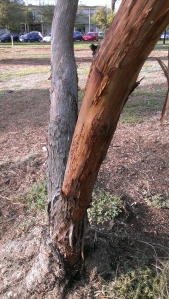
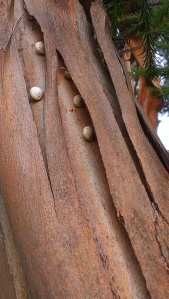
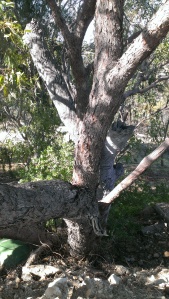
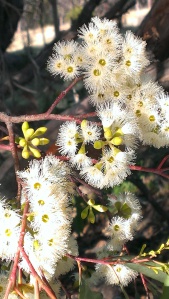
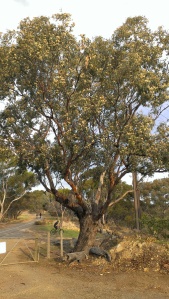
It must be heart breaking losing all these trees. Especially as they have so much to offer. We have such strict planning laws especially where I live in a conservation area and I feel very thankful.
LikeLike
I wish I could say the same about our planning laws, which have decreased protection for “significant trees” in recent years.
LikeLike
I love your first photo, my two favourite things gums and old factories. Can you tell what the strategy for less fibre damage is? Or is a secret..
LikeLike
I think India Flint has published information about how long she thinks is optimal for cooking fibres with eucalypts–and it is a much shorter time than I have sometimes done. being published… it’s not a secret, but her books are in print. Other authors have other methods, and after lacklustre results in my early experiments I ultimately went with Ida Grae’s finding that sometimes it took 3 hours of heat to extract a good colour. When that’s three hours of heat being applied, it certainly can make the fibre harsh if your temperature control is dodgy!
LikeLike
Oh ok, yes I did a class two years ago with her at Beautiful Silks and she said the same, I was just wondering if you had heard something different. I also have her books. I usually have a fire which I boil for a few hours it depends how I feel on the day and how long I can stoke the fire. But each time I always feel like a witch.. which is ok I guess. I also have an old iron caldron which adds to the magic.
LikeLike
I like being part of that tradition of women knowledgeable in plant lore. The persecution part, less so. But other people finding what I do odd is really not up there with being burned at the stake. 🙂 I don’t think India Flint has said something that is a departure from what she said in the past. It appears I’ve understood it better. Or just differently.
LikeLike
Fantastic colours! I am still hunting for eucalypts giving orange or red in my area. Almost everything gives various shades of yellow. Looking at your photos I know it is possible to find them. So sad that you are losing so many trees in your neigbourhood though. Trees give so much and ask for so little.
LikeLike
I agree. Good luck on your quest for eucalypts that give stronger colours. In the first year I was working on eucalypts, I would run a test sample on about one metre of wool yarn. I got all kinds of shades and in the end knit a pair of sampler socks for a friend, with them all arranged in stripes 🙂 I just about never get yellow though. I wonder if that says something about your water as well as the trees that grown near you?
LikeLike
I am really not sure what to make of it. It could also be that I tend to use solar dyeing as my primary form of dyeing. I have a large pot of what I am reasonably sure is E.cinerea and it has given me yellow rather than the orange I was hoping for. It may be that it is not getting hot enough to bring out the orange, especially as temps have dropped considerably here in Canberra in the last few weeks.
LikeLike
I think that’s right–I can’t get deep colours without heat and almost no one I have read says they can. Solar dyeing is perfect for some applications, but like everything else, it is only one variable and changing it changes the results.
LikeLike
Sad for the loss of trees. Too many trees are biting the dust. 😦
But WOW…. the color you reclaimed from it is amazing!
And the other euc experiments…… sigh, they are sublime.
LikeLike
Thankyou! Both for the sympathy and the compliment…
LikeLike
Delighted that my methods stand up to rigorous testing :))
LikeLike
Haha! I am sure you have tested them more rigorously than I ever will. I have been using hayboxing for indigo but not for other dyes… what a fabulous strategy. I continue to be gripped by the experience of trying something as (I understand) someone else describing doing it, and getting a completely different result. Clearly I’ve had a penny drops moment on this particular technique. I couldn’t be more pleased about that! Thanks again.
LikeLike
Not surprised the fence-commentary didn’t last long. I saw it on my way home from getting dinner and laughed (and thought of you, actually – in a completely non-creepy way). Do you know if any new trees are being planted to replace the ones that have gone?
LikeLike
I think there were a few people who were cheered up a little by that effort. The Department of Planning, Transport and Infrastructure is required by law to replace the trees they took out. The larger ones they felled will be replaced by three small trees. But these three were taken out by the landowner and I don’t think they are obliged to do anything.
LikeLike
very sad when trees come down. I am not looking forward to the incursions of the fungal disease that is killing a lot of ash trees here – half our local hedgerow trees are ash, it could be devastating, but some experts say that mature trees can cope with it. Oh, hayboxing … hmm, that sounds a great idea .. I have been reading up on indigo and wondering how to keep the vat warm without spending fast amounts on heat … all these pleasures to come. sadly a snail has got at my japanese indigo seedlings and been hoovering them off as they come up – I am left with one tiny plant. As for eucalypts – here in the UK they only seem to give green – or nothing – but of course, I am a rank beginner at identifying them. I have a good friend who is a florist though, so I get her waste. In Spain I get yellowy goldy colours and purples with iron from the local eucalypts. it’s very difficult to tell what species they are, though nitens is one they plant there a lot. there’s one a short walk away with HUGE leaves … perhaps you can help me identify when I’m out there in a week or so?
LikeLike
Hayboxing is certainly what I do with indigo. I am happy to help if I can, but I can’t pretend to be much of an expert 🙂 There are hundreds of eucalypts. I have never encountered E Nitens!
LikeLike
seems the three main eucs grown in N europe are globulus, nitens and gunnii, they are all cold hardy – mainly with origins in the Tablelands of New South Wales and Victoria and the Tasmanian highlands, and the majority of those in semiarid temperate (Mediterranean) climates are based on E. camaldulensis. it gets quite cold in Extremadura, but not that cold or wet, so I probably have a choice of them being nitens, globulus or camalulensis, I think gunnii’s leaves are smaller.
LikeLike